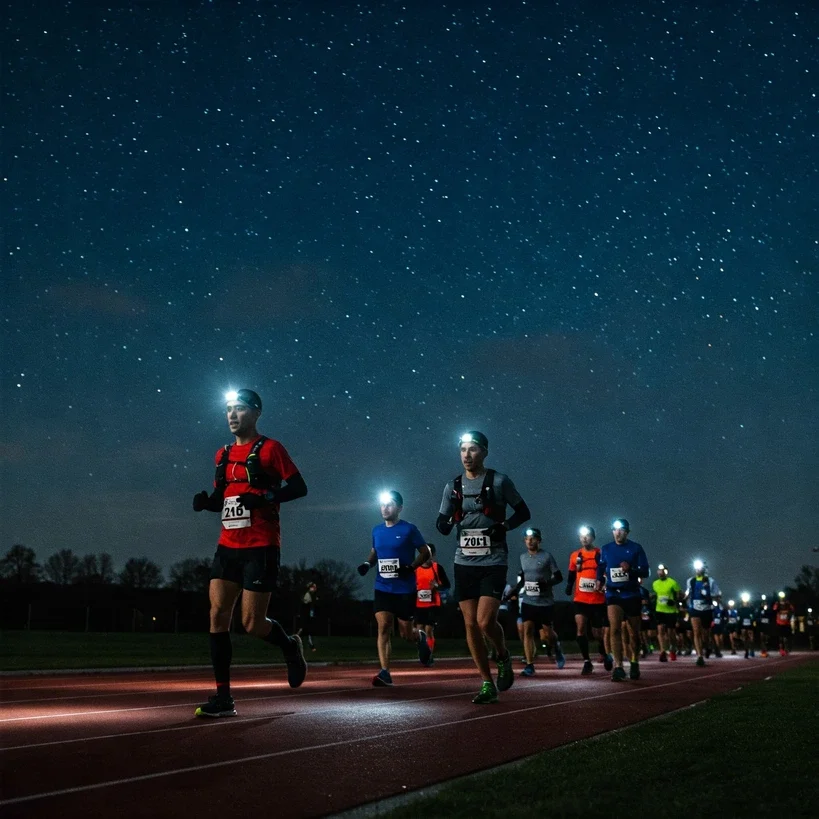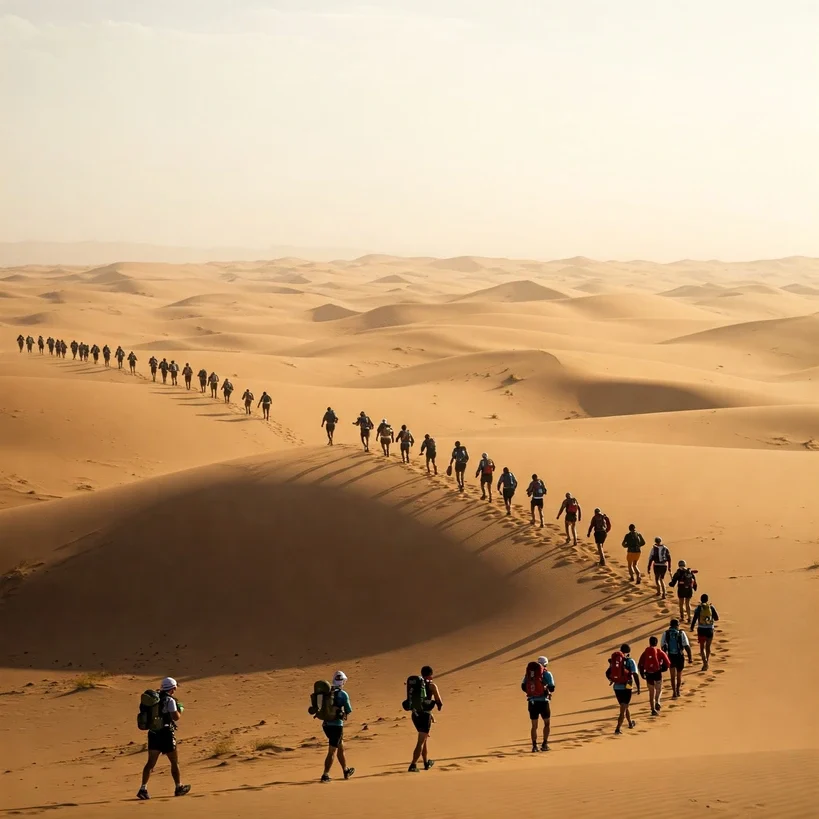Introduction to Ultramarathon Distances
What is an Ultramarathon? Going Beyond the Marathon
An ultramarathon is, at its core, any running race longer than the traditional marathon distance of 42.195 kilometers (26.2 miles). While technically even a fraction longer qualifies, the ultrarunning community generally considers distances of 50 kilometers (about 31 miles) and above as the true starting point for ultra distances.
These events differ significantly from standard marathons. Ultramarathons often traverse challenging terrain like trails, mountains, or deserts, involve substantial elevation changes, and can last anywhere from several hours to multiple days, demanding different strategies for pacing, nutrition, and mental fortitude.
Purpose of This Guide: Your Resource for Understanding Ultra Distances
This guide aims to be a comprehensive resource, delving into the diverse world of ultramarathon distances. We’ll explore the various formats, standard distances, iconic races, historical context, and the governing bodies that shape the sport. Whether you’re a curious newcomer or an experienced ultrarunner, this guide provides the foundational knowledge you need.
A Glimpse into History: From Pedestrianism to Modern Ultras
While modern ultrarunning is relatively young, the human history of long-distance travel on foot is ancient. The sport’s competitive roots can be traced back to 18th and 19th-century endurance walkers and the fascinating era of “Pedestrianism,” where athletes competed, often over six days, to cover the maximum possible distance. Though this trend faded, it laid the groundwork for the timed endurance events we see today.
Ultramarathon Formats: Distance vs. Time
Ultramarathons generally fall into two primary categories based on their objective. Understanding these formats is key to navigating the sport.
Distance-Based Ultramarathons
These races challenge competitors to complete a specific, predetermined distance as quickly as possible. The course is set, and the goal is to reach the finish line.
Distance-based ultras can be structured as:
- Single-Stage: The entire race distance is covered in one continuous effort, although runners will stop briefly at aid stations.
- Multi-Stage: The total distance is broken down into segments (stages) run over several consecutive days, often with planned overnight stops. A famous example is the Marathon des Sables.
Time-Based Ultramarathons
In contrast, time-based events challenge runners to cover as much distance as possible within a fixed duration. The winner is the individual who logs the most mileage before the clock runs out.
Common durations for these events include:
- 6 Hours
- 12 Hours
- 24 Hours
- 48 Hours
- 6 Days (and sometimes longer)
Standard Distance-Based Ultras: Deep Dive
50 Kilometers (50K): The First Step into the Ultra World
Often considered the gateway to ultrarunning, the 50K distance covers approximately 31 miles. It’s a significant step up from the standard marathon (42.195 km) but remains relatively accessible compared to longer ultra distances.
Its popularity stems largely from this accessibility. Many runners transitioning from marathons see the 50K as a logical next challenge. This has fueled significant growth in participation at this distance, making it one of the most commonly contested ultramarathon events globally, attracting both newcomers and experienced runners testing their speed.
Despite being an entry-level distance for many, the 50K holds significant official status. The International Association of Ultrarunners (IAU) organizes World Championships for the 50K. Furthermore, World Athletics (the global governing body for athletics) officially recognizes the 50K as a distance for World Records, solidifying its place within the international structure of the sport.
Numerous prestigious 50K races take place around the world, often showcasing stunning scenery. Some well-known examples include:
- OCC (part of the UTMB series in the Alps)
- Tarawera 50K (New Zealand)
- Broken Arrow Skyrace 52K (California, USA)
- Gorge Waterfalls 50K (Oregon, USA)
50 Miles (50M): The Next Level of Endurance
Covering approximately 80 kilometers, the 50-mile ultramarathon represents a significant increase in difficulty compared to the 50K. This distance truly tests a runner’s endurance, demanding robust training, solid pacing strategies, and effective nutrition management over many hours.
The 50-miler holds a special place in American ultrarunning history. Events like the iconic JFK 50 Mile, the oldest continuously run ultramarathon in the USA (established in 1963), were pivotal in popularizing this distance. It remains a major benchmark and a preferred distance for many experienced ultrarunners in North America and beyond.
Internationally, the 50-mile distance is recognized by the International Association of Ultrarunners (IAU), which ratifies official IAU World Records for this category. This formal recognition highlights its importance within the global ultramarathon landscape.
Many classic and challenging 50-mile races exist worldwide. Some prominent examples include:
- JFK 50 Mile (Maryland, USA)
- Lake Sonoma 50 (California, USA)
- American River 50 Mile (California, USA)
- South Downs Way 50 (UK)
- Silver Rush 50 (Colorado, USA)
100 Kilometers (100K): The International Arena
The 100-kilometer (approximately 62 miles) ultramarathon occupies a significant position in international competition. It represents a substantial test, demanding a blend of speed and endurance that bridges the gap between shorter ultras and the formidable 100-mile distance.
The 100K holds particular prestige within the official structures of the sport. The International Association of Ultrarunners (IAU) considers it a flagship event, having organized World Championships at this distance since 1987. This long history of international championship racing cemented the 100K’s importance long ago.
Adding to its prominence, the 100K is one of the two ultramarathon distances (along with the 50K) for which World Athletics officially recognizes World Records. This top-tier recognition underscores its status as a benchmark distance for elite ultrarunners globally.
Many well-regarded 100K races challenge runners around the world. Notable examples include:
- CCC (part of the UTMB Mont-Blanc series in Europe)
- Black Canyon 100K (Arizona, USA – often a Western States qualifier)
- Millau 100K (France – a historic road race)
- Bandera 100K (Texas, USA)
- Miwok 100K (California, USA)
100 Miles (100M): The Iconic Pinnacle
The 100-mile ultramarathon (approximately 161 kilometers) stands as one of the most revered and challenging benchmarks in endurance sports. Completing a 100-miler is often seen as the ultimate achievement for many ultrarunners, representing an epic journey that tests the limits of physical and mental resilience.
This distance holds a legendary status, particularly within the trail running community. Races like the Western States 100, the world’s oldest 100-mile trail race, pioneered the distance and established its iconic reputation. Tackling formidable terrain, significant elevation changes, and often unpredictable weather over such a long distance requires immense dedication and preparation.
The 100-mile distance is officially recognized by the International Association of Ultrarunners (IAU), which ratifies IAU World Records for both men and women. This acknowledges its importance as a standard, albeit extreme, ultra distance.
Many of the world’s most famous and sought-after ultramarathons are 100-milers. Some key examples include:
- Western States 100-Mile Endurance Run (California, USA)
- Ultra-Trail du Mont-Blanc (UTMB) (France/Italy/Switzerland – approx. 106 miles)
- Hardrock Hundred Mile Endurance Run (Colorado, USA)
- Leadville Trail 100 Run (Colorado, USA)
Time-Based Ultramarathons: Racing Against the Clock
6-Hour and 12-Hour Races
Moving away from fixed distances, time-based ultramarathons challenge runners to cover the maximum possible distance within a set timeframe. The 6-hour and 12-hour formats are popular entry points into this style of racing.
These shorter timed events test a runner’s ability to maintain a consistent pace and manage energy efficiently. While not as grueling as longer timed races, they still require significant physical and mental stamina. They are often held on tracks or short loops, allowing for easy access to aid and precise distance measurement.
The International Association of Ultrarunners (IAU) officially recognizes IAU World Records for both the 6-hour and 12-hour disciplines, highlighting their status as standardized competitive formats.
24-Hour Races: A Popular Classic
The 24-hour race is arguably the most popular and prestigious of the standard time-based ultramarathon formats. It represents a classic test of endurance, strategy, and mental fortitude, pushing runners through a full day-night cycle.
This format enjoys significant international recognition. The IAU holds biennial World Championships for the 24-hour event, attracting elite athletes from around the globe. These championships are often venues for record-breaking performances.
Official IAU World Records are ratified for the 24-hour distance, with top athletes covering astonishing mileage, sometimes exceeding 300 kilometers (over 186 miles). Managing pacing, nutrition, hydration, and potential sleep deprivation are critical components of success.
Several key 24-hour events are staples on the ultrarunning calendar:
- IAU 24-Hour World & Continental Championships
- Self-Transcendence 24 Hour Race (UK and other locations)
- Across the Years (Arizona, USA – includes a 24-hour option)
48-Hour and 6-Day Races: Redefining Endurance
Venturing further into the realm of extreme endurance, the 48-hour and 6-day races push human limits far beyond what most can comprehend. These multi-day events are profound tests of physical stamina, sleep management, nutritional strategy, and sheer mental willpower.
These formats have deep historical roots, directly echoing the Pedestrianism movement of the 19th century, particularly the immensely popular six-day races held indoors. Modern multi-day races revive this tradition, often attracting a dedicated community of specialized ultrarunners.
Official recognition exists for these demanding durations. The IAU ratifies World Records (IAU WR) for the 48-hour event. For the 6-day race, the IAU recognizes official World Best Performances (IAU WBP), a slightly different designation but still marking the pinnacle of achievement at that distance. The Global Organization of Multi-Day Ultramarathoners (GOMU) also plays a role in sanctioning events and tracking records at these longer durations.
While less common than 24-hour races, several notable events cater to multi-day athletes:
- Across the Years (Arizona, USA – offers 48-hour and 6-day options)
- 6 Jours de France (France – includes 48-hour and 6-day formats)
- Self-Transcendence 6 Day Race (New York, USA)
- Various GOMU-sanctioned 48-hour and 6-day championships
Special Race Formats and Iconic Distances
Beyond the standard metric and imperial distances, the ultramarathon world is rich with unique challenges, historical tributes, and innovative formats that push endurance in different ways.
Unique Icons: Comrades and Spartathlon
Some races are famous not just for their length but for their history and unique distances. The Comrades Marathon in South Africa, roughly 88-90km depending on the year’s “up” or “down” run direction, is the world’s oldest and largest ultra. Founded in 1921 as a memorial, it’s a national institution known for its challenging road course and incredible atmosphere.
The Spartathlon follows the legendary 246km (153 miles) route purportedly run by Pheidippides from Athens to Sparta in ancient Greece. Established in 1983, this grueling race demands completion within 36 hours over mixed terrain, including a tough mountain ascent at night. Its historical significance and extreme difficulty make it a revered event.
Multi-Stage Racing: Adventure, Strategy & Self-Sufficiency
Multi-stage races break down immense distances into daily segments run over several days. These events often take place in remote and spectacular locations, emphasizing adventure and sometimes self-sufficiency, requiring runners to carry their own food and gear between overnight camps.
The most famous example is the Marathon des Sables (MdS), a roughly 250km race typically run over 6 stages (7 days) in the Sahara Desert in Morocco. Participants carry mandatory equipment and food, relying on organizers only for water and basic tent shelter, battling extreme heat and sandy terrain.
Other notable stage races include the TransRockies Run in the US Colorado Rockies and the Cape Wrath Ultra across the Scottish Highlands, each offering unique environmental challenges and logistical considerations.
The World’s Longest: Pushing the Boundaries
For those seeking the absolute limits, races extend far beyond 100 miles. The Self-Transcendence 3100 Mile Race, held on a short loop in Queens, New York City, is widely regarded as the world’s longest certified footrace. Runners have 52 days to complete the distance, demanding incredible physical and mental resilience.
The 200+ mile category (approx. 320km+) is also a growing trend, particularly in the US, with challenging trail races like the Moab 240 and Tahoe 200. Italy’s Tor des Géants (~330km) is renowned for its immense elevation gain in the Alps. Historically, transcontinental runs like the “Bunion Derbies” of the 1920s covered thousands of miles, though consistent modern equivalents are rare.
The Backyard Ultra: Different Rules, Endless Challenge
A relatively recent innovation, the Backyard Ultra format, created by Gary “Lazarus Lake” Cantrell, presents a unique endurance test. Runners must complete a 4.167-mile loop every hour, on the hour. The race continues until only one runner can complete a final loop alone.
This format eliminates speed advantages and focuses purely on consistency, pacing, and the mental battle against fatigue and the desire to stop. There’s no fixed finish line; the race only ends when everyone else quits. This accessible yet demanding format has exploded in popularity worldwide.
Choosing Your Path: Trail vs. Road Ultramarathons
Ultramarathons unfold across diverse terrains, primarily falling into two broad categories: trail and road. Understanding the differences is crucial for choosing races and tailoring training.
Trail ultramarathons take place on natural surfaces like dirt paths, single tracks, forest roads, and mountainous terrain. They often feature significant elevation changes, technical footing (rocks, roots, mud), and require specific skills like navigating uneven ground and managing steep climbs and descents. Gear choices, like trail-specific shoes and hydration packs, are often critical.
Road ultramarathons, conversely, are run on paved surfaces like roads or sidewalks. While some may include hills, the terrain is generally more consistent and less technical. Pacing tends to be steadier, and the focus shifts more towards relentless forward motion and managing the repetitive impact on harder surfaces.
In terms of popularity, while major road ultras like Comrades attract huge fields, trail running has seen explosive growth globally. There are far more trail ultra events overall, and studies suggest that the majority of ultramarathon participation growth in recent years has been fueled by trail races. Both formats offer unique challenges and appeal to different types of runners.
The Ultramarathon World: Governance, Records & Trends
Governing Bodies: IAU, WA, GOMU and Their Roles
The sport of ultrarunning, while diverse, has international governing bodies that provide structure. The International Association of Ultrarunners (IAU) is the primary global body, operating under the patronage of World Athletics (WA), the governing body for all athletics.
The IAU’s key roles include organizing World and Continental Championships for standard distances (50K, 100K, 24-Hour), promoting the sport globally, and crucially, standardizing distances and ratifying official records. Organizations like the Global Organization of Multi-Day Ultramarathoners (GOMU) also play a role, particularly for longer multi-day events.
World Records Explained: WA WR vs. IAU WR/WBP
Official recognition of top performances is crucial. World Athletics ratifies official World Records (WA WR) for the 50K and 100K road distances. The IAU ratifies IAU World Records (IAU WR) for 50 miles, 100 miles, 6-hour, 12-hour, 24-hour, and 48-hour events.
For the historic 6-day event, the IAU recognizes World Best Performances (IAU WBP). Achieving an official record requires strict adherence to rules, including competing in IAU-labeled events, accurate course measurement or track certification, and mandatory anti-doping controls.
Beyond overall records, the IAU also meticulously tracks records across numerous age group categories, celebrating the achievements of masters athletes who form a significant part of the ultrarunning community.
Participation Trends and the Sport’s Evolution
Ultramarathoning has experienced phenomenal growth over the past few decades. Studies show participation numbers surged dramatically, particularly between the mid-1990s and the late 2010s.
A key trend is the shift towards shorter ultra distances. While longer races retain their prestige, the most significant participation growth has been in the 50K distance, making the sport more accessible to new runners. Demographically, while still male-dominated, female participation has steadily increased, and the average age of participants has slightly decreased.
This rapid growth has also brought increased commercial interest, leading to discussions within the community about balancing the sport’s grassroots spirit with larger corporate involvement and event organization.
Conclusion: The Meaning and Allure of Ultra Distances
The world of ultramarathon distances is vast and varied, offering a spectrum of challenges that go far beyond the traditional marathon. From the accessible gateway of the 50K to the iconic 100-miler, the relentless pursuit of distance in timed events like the 24-hour or 6-day races, and the unique demands of multi-stage or historically significant runs like Comrades and Spartathlon, there’s a distance and format for nearly every type of endurance enthusiast.
While the specific distances and formats differ, a common thread runs through the sport: the desire to explore personal limits, the deep satisfaction of overcoming immense challenges, and the unique camaraderie found within the ultrarunning community. It’s about more than just covering ground; it’s a journey of self-discovery against the backdrop of demanding courses and extended timeframes.
As the sport continues to grow and evolve, with new formats emerging and participation increasing globally, the fundamental allure of the ultra distance remains. It represents a powerful commitment to pushing boundaries and discovering the extraordinary capacity of the human body and spirit.
Practical Takeaways
Tips for Choosing Your First (or Next) Ultra Distance
- Start Sensibly: If new to ultras, the 50K is often the most logical starting point after mastering the marathon.
- Consider Terrain: Are you more comfortable on roads or trails? Choose races that match your preference and experience. Trail races often require more specific skills and gear.
- Time Commitment: Be realistic about the training required. Longer distances demand significantly more time for training runs and recovery.
- Logistics: Factor in travel, accommodation, crew requirements (for longer races), and mandatory gear when selecting an event.
- Enjoy the Journey: Pick a race location or format that genuinely excites you!
Core Training Principles (Brief Overview)
Ultramarathon training is highly individualized, but some core principles generally apply:
- Consistency: Regular running, week after week, builds the necessary foundation.
- Volume: Gradually increasing weekly mileage is crucial for adapting to long distances.
- Long Runs: Back-to-back long runs are a common technique to simulate late-race fatigue.
- Specificity: Train on terrain similar to your goal race (hills, technical trails, road).
- Strength & Conditioning: Incorporate exercises to build core strength and resilience against injury.
- Nutrition & Hydration: Practice your race-day fuelling strategy during long training runs.
- Rest & Recovery: Adequate sleep and rest days are vital for adaptation and injury prevention.
Further Resources
To continue your exploration of the ultramarathon world, consider these resources:
- Governing Bodies: Websites of the IAU (International Association of Ultrarunners) and World Athletics.
- Race Websites: Official sites for specific races provide detailed course information, rules, and results. (Specific race websites are best found via search engines when researching a particular event).
- Ultrarunning Magazines & Websites: Publications like Ultrarunning Magazine and websites such as iRunFar.com offer news, race reports, and training advice. Regional trail running sites are also valuable.
- Books & Documentaries: Numerous books (like “Born to Run”) and films capture the spirit and challenges of ultramarathon running. Searching online for “ultramarathon books” or “ultramarathon documentaries” will yield many popular options.
- Local Running Clubs: Connecting with local ultra runners through nearby running clubs or groups can provide invaluable community support and practical advice. (Search online for running clubs in your area).





About the Author
Lost Pace is an ultramarathon runner, shoe-tester and the founder of umit.net. Based year-round in Türkiye’s rugged Kaçkar Mountains, he has logged 10,000 + km of technical trail running and completed multiple 50 K–100 K ultras.
Blending mountain grit with data, Lost analyses power (CP 300 W), HRV and nutrition to craft evidence-backed training plans. He has co-written 260 + long-form guides on footwear science, recovery and endurance nutrition, and is a regular beta-tester of AI-driven coaching tools.
When he isn’t chasing PRs or testing midsoles, you’ll find him sharing peer-reviewed research in plain English to help runners train smarter, stay healthier and finish stronger.
Ultrarunner · Data geek · Vegan athlete

